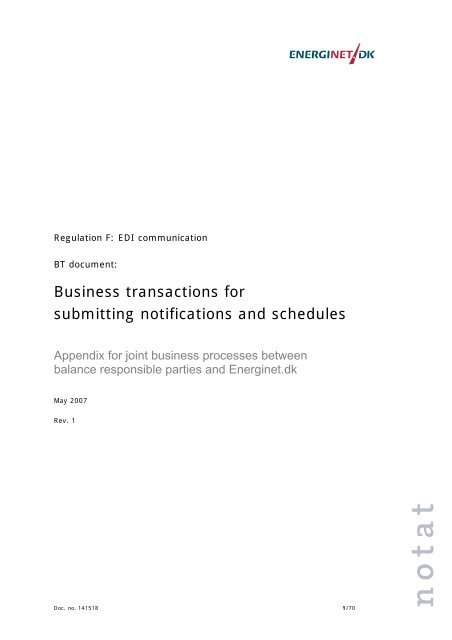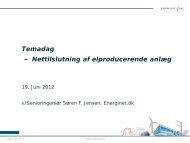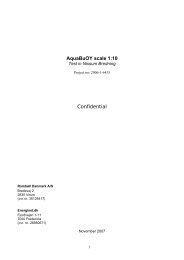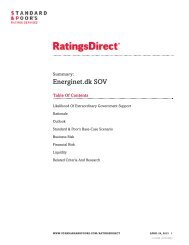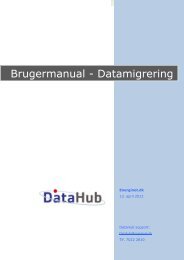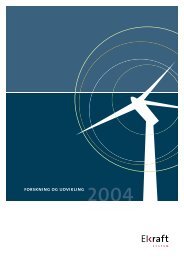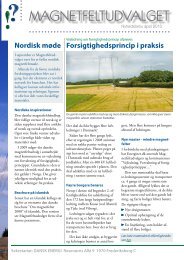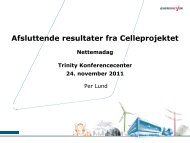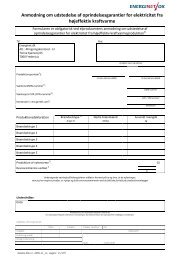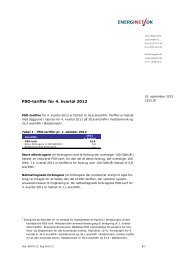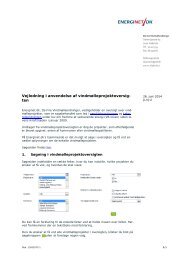Business transactions for submitting notifications and ... - Energinet.dk
Business transactions for submitting notifications and ... - Energinet.dk
Business transactions for submitting notifications and ... - Energinet.dk
You also want an ePaper? Increase the reach of your titles
YUMPU automatically turns print PDFs into web optimized ePapers that Google loves.
Regulation F: EDI communication<br />
BT document:<br />
<strong>Business</strong> <strong>transactions</strong> <strong>for</strong><br />
<strong>submitting</strong> <strong>notifications</strong> <strong>and</strong> schedules<br />
Appendix <strong>for</strong> joint business processes between<br />
balance responsible parties <strong>and</strong> <strong>Energinet</strong>.<strong>dk</strong><br />
May 2007<br />
Rev. 1<br />
Doc. no. 141518 1/70
Table of contents<br />
1 Introduction................................................................................... 4<br />
1.1 Purpose <strong>and</strong> target group...................................................... 4<br />
1.2 <strong>Business</strong> <strong>transactions</strong> ........................................................... 4<br />
1.3 XML Schema Definitions (XSD) .............................................. 4<br />
1.4 References.......................................................................... 6<br />
2 BT-101: Submission of energy <strong>notifications</strong> ........................................ 7<br />
2.1 Transaction initiation ............................................................ 7<br />
2.2 Class diagram ..................................................................... 9<br />
2.3 Dependency matrix .............................................................. 9<br />
2.4 Unique identification........................................................... 10<br />
2.5 Data definitions <strong>for</strong> MarketScheduleTimeSeries ...................... 11<br />
2.6 Examples.......................................................................... 14<br />
3 BT-102: Submission of operational schedules <strong>and</strong> day <strong>for</strong>ecasts .......... 21<br />
3.1 Initiation .......................................................................... 21<br />
3.2 Class diagram ................................................................... 22<br />
3.3 Unique identification........................................................... 23<br />
3.4 Data definitions <strong>for</strong> OperationalScheduleTimeSeries ................ 24<br />
3.5 Sample operational schedule DK1......................................... 26<br />
3.6 Sample operational schedule DK2......................................... 29<br />
3.7 Sample day <strong>for</strong>ecast........................................................... 32<br />
4 BT-103: Submission of regulating power bid..................................... 34<br />
4.1 Initiation .......................................................................... 34<br />
4.2 Data flows ........................................................................ 34<br />
4.3 Class diagram ................................................................... 35<br />
4.4 Unique identification........................................................... 36<br />
4.5 Data definitions <strong>for</strong> BidMessage ........................................... 37<br />
4.6 Example ........................................................................... 40<br />
5 BT104: Submission of regulating power order................................... 42<br />
5.1 Initiation .......................................................................... 42<br />
5.2 Data flows ........................................................................ 42<br />
5.3 Class diagram ................................................................... 43<br />
5.4 Unique identification........................................................... 44<br />
5.5 Data definitions <strong>for</strong> BidActivation.......................................... 44<br />
5.6 Example of planned activation ............................................. 48<br />
5.7 Example of direct activation ................................................ 49<br />
6 BT-105: Submission of 4-week <strong>for</strong>ecast schedule .............................. 50<br />
6.1 Initiation .......................................................................... 50<br />
6.2 Data flows ........................................................................ 50<br />
6.3 Class diagram ................................................................... 51<br />
6.4 Dependency matrix ............................................................ 53<br />
6.5 Unique identification........................................................... 53<br />
6.6 Data definitions <strong>for</strong> OperationalStatusDocument..................... 54<br />
6.7 Example ........................................................................... 57<br />
7 Confirmation (acknowledgement).................................................... 59<br />
7.1 Class diagram ................................................................... 59<br />
Doc. no. 141518 2/70
7.2 Unique identification........................................................... 60<br />
7.3 Data definitions <strong>for</strong> acknowledgement document .................... 60<br />
7.4 Example of overall acknowledgement.................................... 61<br />
7.5 Example of acknowledgement at time series level................... 62<br />
8 Data definitions <strong>for</strong> header in<strong>for</strong>mation ............................................ 64<br />
9 Appendix – Codes used <strong>for</strong> <strong>submitting</strong> <strong>notifications</strong> <strong>and</strong> schedules ....... 67<br />
9.1 Document type list............................................................. 67<br />
9.2 Process type ..................................................................... 67<br />
9.3 Role................................................................................. 67<br />
9.4 <strong>Business</strong> type.................................................................... 67<br />
9.5 Measuring unit .................................................................. 68<br />
9.6 Product ............................................................................ 68<br />
9.7 Currency .......................................................................... 68<br />
9.8 Coding scheme.................................................................. 69<br />
9.9 UnitIdentificationTypeList.................................................... 69<br />
9.10 <strong>Business</strong>Type type ............................................................. 69<br />
9.11 Reason codes .................................................................... 69<br />
9.12 Status Type List................................................................. 69<br />
Doc. no. 141518 3/70
1 Introduction<br />
This document describes the collection of business <strong>transactions</strong> included in the<br />
document named "H<strong>and</strong>ling of <strong>notifications</strong> <strong>and</strong> schedules in the Danish electricity<br />
market".<br />
The document specifies the h<strong>and</strong>ling of the business <strong>transactions</strong> <strong>for</strong> the following<br />
business processes:<br />
• Notification (BS-101)<br />
• Operational schedule (BS-102)<br />
• Regulating power bid <strong>and</strong> order (BS-103)<br />
• 4-week <strong>for</strong>ecast schedule (BS-104)<br />
• Day <strong>for</strong>ecast (BS-105)<br />
1.1 Purpose <strong>and</strong> target group<br />
The purpose of the document is to clarify <strong>and</strong> describe business <strong>transactions</strong> as well as<br />
the content of data <strong>for</strong> the processes listed above. The target group includes balance<br />
responsible parties (BRPs) required to submit <strong>notifications</strong> <strong>and</strong> schedules to<br />
<strong>Energinet</strong>.<strong>dk</strong> <strong>and</strong> their system suppliers.<br />
1.2 <strong>Business</strong> <strong>transactions</strong><br />
In this document, a business transaction complies with the rules specified in<br />
Regulation F, EDI communication, <strong>and</strong> relevant appendices. A business transaction is<br />
independent of other business <strong>transactions</strong> <strong>and</strong> can be included, together with other<br />
<strong>transactions</strong>, in one or more business processes.<br />
A business transaction describes the process of exchanging messages between the IT<br />
systems of two players. It also specifies part of the internal h<strong>and</strong>ling processes within<br />
a player’s IT system; an activity diagram is used <strong>for</strong> this purpose.<br />
The process of exchanging messages between IT systems is illustrated in an activity<br />
diagram where the name of the message as well as the players included are stated.<br />
(the Danish role model is used).<br />
The receiver must validate the message according to a validation table included in the<br />
business transaction <strong>and</strong> subsequently send a reply.<br />
Each individual message contains a list of attributes shown in the <strong>for</strong>m of a class<br />
diagram, <strong>and</strong> a dependency matrix is used in some cases. A dependency matrix is<br />
used if it is possible to send a message with different attributes depending on the<br />
purpose in question.<br />
1.3 XML Schema Definitions (XSD)<br />
All XML Schema Definitions relevant <strong>for</strong> messages affected by business <strong>transactions</strong><br />
described in this document can be found at the following address:<br />
http://edi.energinet.<strong>dk</strong>/schemas<br />
Links will be set up at <strong>Energinet</strong>.<strong>dk</strong>'s website on the pages <strong>for</strong> BRPs. Links will also be<br />
set up from the self-service portal.<br />
Doc. no. 141518 4/70
1.3.1 Versioning <strong>for</strong> XML schema<br />
XML schemas developed <strong>for</strong> communication between <strong>Energinet</strong>.<strong>dk</strong> <strong>and</strong> its external<br />
partners use a target namespace which is designed in the following way:<br />
“http://www.energinet.<strong>dk</strong>/schemas/”/+<br />
/v<br />
The example below shows how the namespace can appear <strong>for</strong> the XML schema<br />
concerning BRPs’ exchange of <strong>notifications</strong>:<br />
http://www.energinet.<strong>dk</strong>/schemas/BalRespXML/MarketScheduleDocument/<br />
v2<br />
The XML schemas are versioned using the file name. It is a construction of the name of<br />
the XML schema’s root element combined with the version number. The combination of<br />
the two parts is separated by a - (hyphen) as shown below:<br />
-.xsd”<br />
The example below shows the naming of the first version of an XML schema where the<br />
root element is named “MarketScheduleDocument”:<br />
MarketScheduleDocument-1.xsd<br />
In addition to the version number, the “version” attribute in the schema element must also reflect<br />
the release number separated by a full stop. The following example applies to version 2, release<br />
4:<br />
version=”2.4”<br />
A version number change is due to structural changes to the schema. Structural changes may<br />
include the addition or removal of elements, name changes of elements or attributes, or changes<br />
to the structure of the elements. A change of the release number will be due to minor changes.<br />
Minor changes may include the addition of optional elements, changes to rules of attribute<br />
content (provided that these changes do not have a limiting effect) <strong>and</strong> the like. In other words,<br />
no elements are removed from the structure.<br />
It must thus be possible to use several different releases of an XML schema version without them<br />
conflicting with each other (ie they must be reverse compatible). However, a previous version of<br />
an XML schema will conflict with a more recent version. <strong>Energinet</strong>.<strong>dk</strong> ensures continuous<br />
processing of the most recent released version as well as its predecessor. There will thus always<br />
be two different versions available with several releases of each version.<br />
1.3.2 Access to web services<br />
<strong>Energinet</strong>.<strong>dk</strong>’s web services are accessed at the<br />
addresshttp://edi.energinet.<strong>dk</strong>/BRService.asmx via the Internet or a special IP address<br />
via the MPLS network. Players solely <strong>submitting</strong> <strong>notifications</strong> can choose whether to<br />
access the web service via MPLS or the Internet.<br />
The web service is accessed via a secure connection (https) <strong>and</strong> requires authenticity<br />
in the <strong>for</strong>m of the player’s login to the self-service portal.<br />
Doc. no. 141518 5/70
All web service methods use the login to determine which player sends/receives<br />
messages.<br />
The following methods are accessible via the web service:<br />
int[] GetMessageList(datetime utcFrom, datetime utcTo)<br />
Retrieves messages sent to the player within the given interval.<br />
int[] GetMessageList(datetime utcFrom, datetime utcTo, string messageType)<br />
Retrieves messages of the given type sent to the player within the given interval. The<br />
attribute messageType indicates the root node name of the message type required, eg<br />
"MarketScheduleDocument".<br />
int[] GetNewMessages()<br />
Retrieves all as yet unretrieved messages.<br />
int[] GetNewMessages(string messageType)<br />
Retrieves all as yet unretrieved messages of the given type.<br />
XmlDocument GetMessage(int id)<br />
Retrieves the message with the specific ID.<br />
int SendMessage(XmlDocument message)<br />
Submits message, operational schedule, notification, bid, capacity schedule.<br />
Returns code 0 if the message has been received.<br />
1.4 References<br />
The document refers to the following documents:<br />
• BS document "H<strong>and</strong>ling of <strong>notifications</strong> <strong>and</strong> schedules in the Danish electricity<br />
market"<br />
• Regulation C3 "H<strong>and</strong>ling of <strong>notifications</strong> <strong>and</strong> schedules – daily procedures"<br />
• Regulation F "EDI communication"<br />
• ETSO GENERAL Code List For Data Interchange<br />
• XML schema definitions<br />
• Message Implementation Guidelines (MIG)<br />
• Code lists <strong>for</strong> MIG<br />
Doc. no. 141518 6/70
2 BT-101: Submission of energy <strong>notifications</strong><br />
The BT-101 transaction is used by the BRPs <strong>for</strong> <strong>submitting</strong> an XML message which<br />
contains all energy <strong>notifications</strong> <strong>for</strong> the roles they assume to a transmission system<br />
operator (TSO). The collective set of energy <strong>notifications</strong> from a BRP is called a<br />
notification.<br />
Figure 1 - Activity diagram <strong>for</strong> BT-101. Submission of energy <strong>notifications</strong><br />
Translation of figure text:<br />
Aktør A = Player A<br />
Modtager aktørplan = Receives notification<br />
Validerer aktørplan = Validates notification<br />
Sender bekræftelse = Sends acknowledgement<br />
Aktør B = Player B<br />
Sender aktørplan = Submits notification<br />
Modtager bekræftelse = Receives acknowledgement<br />
Negativ bekræftelse = Negative acknowledgement<br />
Positiv bekræftelse = Positive acknowledgement<br />
The roles that a player can assume are trade, consumption or production. Only one<br />
message per player must be submitted, comprising the full responsibility <strong>for</strong> a price<br />
area.<br />
This means that a player must submit separate <strong>notifications</strong>/schedules <strong>for</strong> both DK1<br />
<strong>and</strong> DK2 price areas if the player is active in both areas.<br />
In addition, this message is also used <strong>for</strong> confirmation reports from the TSO to BRP.<br />
2.1 Transaction initiation<br />
The transaction is initiated by an XML message (MarketScheduleDocument) with the<br />
ProcessType "DK-TIS-SCH" (Market scheduling), which contains <strong>notifications</strong>/schedules<br />
<strong>for</strong> trade, consumption <strong>and</strong> production.<br />
Doc. no. 141518 7/70
The message is used both <strong>for</strong> <strong>submitting</strong> <strong>notifications</strong>/schedules the day be<strong>for</strong>e the<br />
day of operation (day ahead <strong>notifications</strong>) <strong>and</strong> <strong>notifications</strong> during the day of operation<br />
(intraday <strong>notifications</strong>) as well as confirmation reports.<br />
2.1.1 First data flow<br />
The player will submit its energy <strong>notifications</strong> in accordance with the class diagram<br />
(see Figure 2) <strong>and</strong> the dependency matrix, or the TSO will <strong>for</strong>ward confirmation<br />
reports.<br />
On receipt, the message is validated according to the rules contained in Regulation F.<br />
Then the full message is validated according to the following rules:<br />
2.1.2 Valid data <strong>for</strong> submission of energy <strong>notifications</strong><br />
MessageHeader<br />
• DocumentIdentification must together with DocumentVersion be unique<br />
• SenderIdentification must contain the existing GLN/EIC code<br />
• RecieverIdentification must contain the existing GLN/EIC code<br />
• DocumentDateTime must be in the correct <strong>for</strong>mat (YYYY-MM)<br />
• ScheduleTimeInterval must be 24 hours<br />
• Domain must contain one of the below-mentioned Area types <strong>for</strong> Denmark<br />
MarketSchedueleTimeSeries<br />
• TimeSeriesIdentification must be unique in the message<br />
• <strong>Business</strong>Type must be a valid code<br />
• If filled in: InArea must contain the EIC code<br />
• If filled in: OutArea must contain the EIC code<br />
• InParty must contain the existing GLN/EIC code<br />
• If filled in, OutParty must contain the existing GLN/EIC code<br />
• TimeInterval must be 24 hours<br />
• Resolution must be 1 hour (PT1H)<br />
• Position must contain 24 values (however, 23 <strong>and</strong> 25 when changing to<br />
st<strong>and</strong>ard/daylight saving time, respectively)<br />
• Quantity must be a value to max. one decimal point<br />
The used identifications <strong>for</strong> Area types are<br />
o 10YDK-1--------W (Western Denmark)<br />
o 10YDK-2--------E (Eastern Denmark)<br />
o 10YDE-EON------1 (Germany)<br />
2.1.3 Second data flow: Acknowledgement document<br />
If the message can be validated in relation to schemas, <strong>and</strong> the content meets all<br />
validations in the above validation list, the overall notification is approved by means of<br />
an acknowledgement with the code A01.<br />
In the event of verification errors in relation to the schema or the content, the<br />
message must be rejected. The acknowledgement will then contain an error code <strong>and</strong><br />
an explanatory text.<br />
The acknowledgement will always contain a reference to the original message <strong>and</strong><br />
must be processed in accordance with the rules specified in Regulation F.<br />
Doc. no. 141518 8/70
2.2 Class diagram<br />
In addition to the MessageHeader, a notification includes the<br />
MarketScheduleTimeSeries class, which is a time series covering a given period of<br />
time.<br />
MessageHeader<br />
-DocumentIdentification[1]<br />
-DocumentVersion[1]<br />
-DocumentType[1]<br />
-ProcessType[1] = DK-TIS-SCH<br />
-SenderIdentification[1]<br />
-SenderRole[1]<br />
-RecieverIdentification[1]<br />
-RecieverRole[1] =<br />
-DocumentDateTime[1]<br />
-ScheduleTimeInterval[1]<br />
-Domain[1]<br />
0..*<br />
MarketScheduleTimeSeries<br />
-TimeSeriesIdentification[1]<br />
-TimeSeriesVersion[1] = 1<br />
-<strong>Business</strong>Type[1]<br />
-Product[1] = 8716867000030<br />
-InArea[0..1]<br />
-OutArea[0..1]<br />
-InParty[0..1]<br />
-OutParty[0..1]<br />
-MeassurementUnit[1] = MAW<br />
Period<br />
1 -TimeInterval[1]<br />
-Resolution[1]<br />
1..*<br />
Interval<br />
-Position[1]<br />
-Quantity[1]<br />
-Status[0..1]<br />
<strong>Business</strong>TypeList<br />
-A01 Production<br />
-A04 Consumption<br />
-A06 External Trade<br />
-A08 Internal Trade<br />
-Z01 Adjustable Production<br />
-Z04 Adjustable Consumption<br />
DocumentTypeList<br />
-A01 Balance responsible schedule<br />
-A07 Intermediate Confirmation Report<br />
-A08 Final Confirmation Report<br />
RoleTypeList<br />
-A01 HBA<br />
-A02 FBA<br />
-A04 TSO<br />
-A06 PBA<br />
-A08 BA<br />
CodingSchemeType<br />
-A01<br />
-A10<br />
Possible options from code lists<br />
StatusTypeList<br />
-Z01 Operational<br />
-Z02 Reduced Operational<br />
-Z03 Non Operational<br />
-Z04 Revision<br />
-Z05 Suspended<br />
-Z06 Crashed<br />
-Z07 Discarded<br />
-Z11 Planned<br />
-Z12 Counterpart Imbalance<br />
-Z13 Internal Imbalance<br />
Figure 2 - Class diagram <strong>for</strong> MarketScheduleDocument (notification)<br />
2.3 Dependency matrix<br />
The following dependency matrix defines the elements that are m<strong>and</strong>atory, optional or<br />
not used in relation to the different business types. If the cells are merged, <strong>and</strong> only<br />
one value is shown, only this value applies to all business types.<br />
Doc. no. 141518 9/70
Time series<br />
Dependency matrix<br />
<strong>for</strong> BT-101<br />
Adj. production<br />
Non-adj. production<br />
Adj. consumption<br />
Non-adj. consumption<br />
Internal trade<br />
External trade<br />
Total trade<br />
TSO adjustment<br />
Balance deviation<br />
Internal trade, counterpart<br />
Difference<br />
Adj. notification/schedule<br />
Notification O O O O O O B B B B B B<br />
Use<br />
Preliminary confirmation report O O O O O O M M M O O O<br />
Partially final confirmation report O O O O O O M M M O O O<br />
Element names<br />
Final confirmation report O O O O O O M M M B B B<br />
MarketScheduleTimeSeries<br />
TimeSeriesIdentification M M M M M M M M M M M M<br />
TimeSeriesVersion M M M M M M M M M M M M<br />
<strong>Business</strong>Type Z01 A01 Z04 A04 A08 A06 A24 TSA A19 Z05 DIF TOA<br />
Product 8716867000030<br />
InArea M M B B M M M M M M M M<br />
OutArea B B M M M M B B B M M M<br />
InParty M M B B M M M M M M M M<br />
OutParty B B M M M M B B B M M M<br />
MeasurementUnit M M M M M M M M M M M M<br />
Period<br />
TimeInterval M M M M M M M M M M M M<br />
Resolution<br />
PT1H<br />
Interval<br />
Position M M M M M M M M M M M M<br />
Quantity M M M M M M M M M M M M<br />
Status B B B B B B M M M M M M<br />
M – m<strong>and</strong>atory O – optional B – not used<br />
2.4 Unique identification<br />
BT ID<br />
DK-BT-101<br />
BT name<br />
Submission of energy <strong>notifications</strong><br />
BT version 1<br />
BT combined ID DK-BT-101-001<br />
BPI<br />
DK-TIS-SCH<br />
Edi Documents:<br />
Document ID XML<br />
Document name MarketScheduleDocument-13.xsd<br />
Document IG version 13.8<br />
Doc. no. 141518 10/70
Document ID XML<br />
Document name AcknowledgementDocument-13.xsd<br />
Document IG version 13.8<br />
2.5 Data definitions <strong>for</strong> MarketScheduleTimeSeries<br />
TimeSeriesIdentification<br />
Description: Unique identification of the sender of the time series referred to<br />
Code<br />
Classification<br />
M<strong>and</strong>atory<br />
Size<br />
an..35<br />
Type<br />
ecc:IdentificationType<br />
Example<br />
<br />
Comment<br />
TimeSeriesVersion<br />
Description: The version of the time series being submitted<br />
Code<br />
Classification<br />
M<strong>and</strong>atory<br />
Size<br />
n..3<br />
Type<br />
ecc:VersionType<br />
Example<br />
<br />
Comment Is always set to 1<br />
<strong>Business</strong>Type<br />
Description: The type of time series included. This could be a time series <strong>for</strong><br />
consumption or non-adjustable production<br />
Code<br />
Classification<br />
Size<br />
Type<br />
See <strong>Business</strong> type code list<br />
M<strong>and</strong>atory<br />
an..3<br />
head:<strong>Business</strong>Type<br />
Example <br />
Comment<br />
Product<br />
Description: Identification of the product included.<br />
The product could be energy or power<br />
Code<br />
See Product code list<br />
Classification<br />
M<strong>and</strong>atory<br />
Size<br />
an..13<br />
Type<br />
ecc:EnergyProductType<br />
Example<br />
<br />
Comment<br />
Doc. no. 141518 11/70
InArea<br />
Description: Identification of the area where the product is received<br />
Code<br />
Classification<br />
Optional<br />
Size<br />
an..18<br />
Type<br />
ecc:AreaType<br />
Example<br />
<br />
Comment<br />
codingScheme is used<br />
OutArea<br />
Description: Identification of the area from where the product is sent<br />
Code<br />
Classification<br />
Optional<br />
Size<br />
an..18<br />
Type<br />
ecc:AreaType<br />
Example<br />
<br />
Comment<br />
codingScheme is used<br />
InParty<br />
Description: Identification of the party receiving a product<br />
Code<br />
Classification<br />
M<strong>and</strong>atory<br />
Size<br />
an..35<br />
Type<br />
ecc:PartyType<br />
Example<br />
<br />
Comment<br />
codingScheme is used<br />
OutParty<br />
Description: Identification of the party sending a product<br />
Code<br />
Classification<br />
Optional<br />
Size<br />
an..35<br />
Type<br />
ecc:PartyType<br />
Example<br />
<br />
Comment<br />
codingScheme is used<br />
Doc. no. 141518 12/70
MeasurementUnit<br />
Description: The unit used to measure the individual values.<br />
The unit could be MWh or kW<br />
Code<br />
See the MeasurementUnit code list<br />
Classification<br />
M<strong>and</strong>atory<br />
Size<br />
an..3<br />
Type<br />
ecc:UnitOfMeasureType<br />
Example<br />
<br />
Comment<br />
2.5.1 Period<br />
TimeInterval<br />
Description: Start <strong>and</strong> end of time interval <strong>for</strong> the period processed<br />
Code<br />
Classification<br />
Size<br />
Type<br />
Example<br />
Comment<br />
M<strong>and</strong>atory<br />
an..35<br />
ecc:TimeIntervalType<br />
<br />
The <strong>for</strong>mat is YYYY-MM-DDThh:mmZ/ YYYY-MM-<br />
DDThh:mmZ., <strong>and</strong> the time is stated in UCT.<br />
Resolution<br />
Description: The resolution determines the degree of detail provided in terms of<br />
time interval<br />
Code<br />
Classification<br />
Size<br />
Type<br />
Example<br />
Comment<br />
M<strong>and</strong>atory<br />
an..14<br />
ecc:ResolutionType<br />
<br />
The resolution is expressed by ISO 8601 in the<br />
following <strong>for</strong>mat: PnYnMnDTnHnMnS. If the period<br />
is indicated in hours, minutes <strong>and</strong> seconds, "T"<br />
must be included. For example, PT1H indicates a<br />
resolution of 1 hour, while PT5M indicates a<br />
resolution of 5 minutes.<br />
2.5.2 Interval<br />
Position<br />
Description: The relative position <strong>for</strong> a period in an interval<br />
Code<br />
Classification<br />
M<strong>and</strong>atory<br />
Size<br />
n..6<br />
Doc. no. 141518 13/70
Type<br />
Example<br />
Comment<br />
ecc:PositionType<br />
<br />
The position is specified by a numerical integer<br />
starting with 1<br />
Quantity<br />
Description: Quantity specification <strong>for</strong> a position in a given interval.<br />
Code<br />
Classification<br />
M<strong>and</strong>atory<br />
Size<br />
n..18<br />
Type<br />
ecc:QuantityType<br />
Example<br />
<br />
Comment<br />
The quantity is specified in the unit stated in the<br />
MeasurementUnit element<br />
Status<br />
Description: Code <strong>for</strong> quantity status<br />
Code<br />
See StatusTypeList code list<br />
Classification<br />
Optional<br />
Size<br />
an..3<br />
Type<br />
head:StatusType<br />
Example <br />
Comment<br />
Used in connection with confirmation reports<br />
2.6 Examples<br />
2.6.1 Notification<br />
<br />
<br />
<br />
<br />
<br />
<br />
<br />
<br />
<br />
<br />
<br />
<br />
<br />
<br />
<br />
<br />
<br />
Doc. no. 141518 14/70
<br />
<br />
<br />
<br />
<br />
<br />
<br />
<br />
<br />
<br />
<br />
<br />
…..<br />
<br />
<br />
<br />
<br />
<br />
<br />
<br />
<br />
<br />
<br />
<br />
<br />
<br />
<br />
<br />
<br />
<br />
<br />
..........<br />
<br />
<br />
<br />
<br />
<br />
<br />
<br />
<br />
<br />
<br />
<br />
<br />
<br />
<br />
<br />
<br />
<br />
<br />
<br />
……..<br />
<br />
<br />
<br />
<br />
<br />
<br />
<br />
Doc. no. 141518 15/70
<br />
<br />
<br />
<br />
<br />
<br />
<br />
<br />
<br />
........<br />
<br />
<br />
<br />
<br />
<br />
2.6.2 Preliminary confirmation report<br />
The example does not comprise all the time series submitted.<br />
<br />
<br />
<br />
<br />
<br />
<br />
<br />
<br />
<br />
<br />
<br />
<br />
<br />
<br />
<br />
<br />
<br />
<br />
<br />
<br />
<br />
<br />
<br />
<br />
<br />
<br />
<br />
<br />
........<br />
<br />
Doc. no. 141518 16/70
<br />
<br />
<br />
<br />
<br />
<br />
<br />
<br />
<br />
<br />
<br />
<br />
<br />
<br />
<br />
……<br />
<br />
<br />
<br />
<br />
<br />
<br />
<br />
<br />
<br />
<br />
<br />
<br />
<br />
<br />
<br />
<br />
………<br />
<br />
<br />
<br />
<br />
<br />
<br />
<br />
<br />
<br />
<br />
<br />
<br />
<br />
<br />
<br />
<br />
<br />
<br />
<br />
<br />
<br />
<br />
<br />
<br />
<br />
<br />
<br />
<br />
<br />
<br />
<br />
<br />
<br />
<br />
2.6.3 Final confirmation report<br />
The example does not comprise all the time series submitted.<br />
<br />
<br />
<br />
<br />
<br />
<br />
<br />
<br />
<br />
<br />
<br />
<br />
<br />
<br />
<br />
<br />
<br />
<br />
<br />
<br />
<br />
<br />
<br />
<br />
<br />
<br />
<br />
Doc. no. 141518 18/70
........<br />
<br />
<br />
<br />
<br />
<br />
<br />
<br />
<br />
<br />
<br />
<br />
<br />
<br />
<br />
<br />
<br />
<br />
………..<br />
<br />
<br />
<br />
<br />
<br />
<br />
<br />
<br />
<br />
<br />
<br />
<br />
<br />
<br />
<br />
<br />
<br />
<br />
<br />
.................<br />
<br />
<br />
<br />
<br />
<br />
<br />
<br />
<br />
<br />
<br />
<br />
<br />
<br />
<br />
<br />
<br />
<br />
<br />
<br />
………………<br />
<br />
<br />
<br />
<br />
<br />
<br />
<br />
<br />
<br />
<br />
<br />
<br />
<br />
<br />
<br />
<br />
<br />
<br />
………..<br />
<br />
<br />
<br />
<br />
Doc. no. 141518 20/70
3 BT-102: Submission of operational schedules <strong>and</strong> day<br />
<strong>for</strong>ecasts<br />
<strong>Business</strong> transaction BT-102 is used by the BRPs <strong>for</strong> <strong>submitting</strong> an XML message<br />
containing time series <strong>for</strong> the BRP’s scheduled production <strong>and</strong>/or consumption. The<br />
message is also used <strong>for</strong> <strong>submitting</strong> in<strong>for</strong>mation about different reserves <strong>and</strong> the<br />
maximum <strong>and</strong> minimum capacities of different units <strong>for</strong> the period.<br />
Figure 3 - Activity diagram <strong>for</strong> BT-101 Submission of operational schedules <strong>and</strong> day <strong>for</strong>ecasts<br />
Translation of figure text:<br />
Aktør A = Player A<br />
Modtager køreplan = Receives operational schedule<br />
Validerer køreplan = Validates operational schedule<br />
Sender bekræftelse = Sends confirmation<br />
Aktør B = Player B<br />
Sender køreplan = Submits operational schedule<br />
Modtager bekræftelse = Receives acknowledgement<br />
Positiv bekræftelse = Positive acknowledgement<br />
Negativ bekræftelse = Negative acknowledgement<br />
Nye effektplaner = New power schedules<br />
3.1 Initiation<br />
The transaction is initiated with an XML message called OperationalSchedule-<br />
Document. The message contains several time series which may have the same or<br />
different <strong>Business</strong>Types.<br />
3.1.1 First data flow: Operational schedule<br />
The player submits its schedules in accordance with the relevant class diagram.<br />
On receipt, data submitted is validated according to the rules contained in Regulation<br />
F. Then the full notification is validated in accordance with the following rules:<br />
Doc. no. 141518 21/70
3.1.2 Valid data <strong>for</strong> operational schedules <strong>and</strong> day <strong>for</strong>ecasts<br />
MessageHeader<br />
• DocumentIdentification must together with DocumentVersion be unique<br />
• SenderIdentification must contain the existing GLN/EIC code<br />
• RecieverIdentification must contain the existing GLN/EIC code<br />
• DocumentDateTime must be in the correct <strong>for</strong>mat (YYYY-MM-DDThh:mm:ssZ)<br />
• ScheduleTimeInterval must be 24 hours<br />
• Domain must contain one of the below-mentioned Area types<br />
OperationalScheduleTimeSeries<br />
• TimeSerieIdentification must be unique in the message<br />
• <strong>Business</strong>Type must be a valid code<br />
• UnitIdentification or UnitTypeIdentification must be filled in<br />
• TimeInterval must be 24 hours<br />
• Resolution depends on where the message is used. Either 1 hour (PT01H) or 5<br />
minutes (PT05M) is indicated.<br />
• Position depends on resolution, from 1 to either 24 or 289<br />
• Quantity must be a value to max. one decimal point<br />
The following area type identifications are used:<br />
o 10YDK-1--------W (Western Denmark)<br />
o 10YDK-2--------M (Eastern Denmark)<br />
3.1.3 Second data flow: Acknowledgement document<br />
If the message can be validated in relation to schemas, <strong>and</strong> the content meets all<br />
validations in the above validation list, the overall operational schedule is approved by<br />
an acknowledgement with the code A01.<br />
In the event of verification errors in relation to the schema or the content, the<br />
notification must be rejected. The acknowledgement will then contain an error code<br />
<strong>and</strong> an explanatory text.<br />
The acknowledgement will always contain a reference to the original message <strong>and</strong><br />
must be processed in accordance with the rules specified in Regulation F.<br />
3.2 Class diagram<br />
In addition to the MessageHeader, an operational schedule includes the<br />
OperationalScheduleTimeSeries class, which is a time series covering a given period of<br />
time.<br />
Doc. no. 141518 22/70
MessageHeader<br />
-DocumentIdentification[1]<br />
-DocumentVersion[1]<br />
-DocumentType[1] = A01<br />
-ProcessType[1] = DK-OP<br />
-SenderIdentification[1]<br />
-SenderRole[1] = A08<br />
-RecieverIdentification[1]<br />
-RecieverRole[1] = A04<br />
-DocumentDateTime[1]<br />
-ScheduleTimeInterval[0..1]<br />
-Domain[0..1]<br />
0..*<br />
OperationalScheduleTimeSeries<br />
-TimeSeriesIdentification[1]<br />
-TimeSeriesVersion[1]<br />
-<strong>Business</strong>Type[1]<br />
-Product[1]<br />
-MeassurementUnit[1]<br />
-UnitIdentification[0..1]<br />
-UnitTypeIdentification[0..1]<br />
1<br />
Period<br />
-TimeInterval[1]<br />
-Resolution[1]<br />
1..*<br />
Interval<br />
-Position[1]<br />
-Quantity[1]<br />
<strong>Business</strong>TypeList<br />
-Z01 Adjustable Production<br />
-Z04 Adjustable Consumption<br />
-MIN Technical Minimum<br />
-MAX Technical Maximum<br />
-TMI Total Minimum<br />
-TMA Total Maximum<br />
-R15 15 Minutes Reserves<br />
-R60 60 Minutes Reserves<br />
-R90 90 Minutes Reserves<br />
-LFC LFC Reserves<br />
-FNR Freq. Contr. Norm. Oper. Res.<br />
-FDR Freq. Contr. Oper. Dist. Res.<br />
-PRR Primary Reserves<br />
Product<br />
-8716867000016<br />
-8716867000023<br />
UnitIdentificationList<br />
-PQ Decentral Production<br />
-PW Wind Production<br />
-FQ Decentral Consumption<br />
Mulige valg fra kodelister<br />
MeasurementTypeList<br />
-MAW<br />
-MWH<br />
Figure 4 - Class diagram <strong>for</strong> OperationalScheduleDocument<br />
Translation of figure text:<br />
Mulige valg fra kodelister = Possible options from code lists<br />
3.3 Unique identification<br />
BT ID<br />
BT name<br />
BT version 1<br />
BT-combined ID DK-BT-102-001<br />
DK-BT-102<br />
Submission of operational schedules <strong>and</strong> day<br />
<strong>for</strong>ecasts<br />
Doc. no. 141518 23/70
BPI<br />
DK-OP<br />
Edi Documents:<br />
Document ID XML<br />
Document name OperationalScheduleDocument-13.xsd<br />
Document IG version 13.8<br />
Document ID XML<br />
Document name AcknowledgementDocument-13.xsd<br />
Document IG version 13.8<br />
3.4 Data definitions <strong>for</strong> OperationalScheduleTimeSeries<br />
TimeSeriesVersion<br />
Description: The version of the time series being submitted<br />
Code<br />
Classification<br />
M<strong>and</strong>atory<br />
Size<br />
n..3<br />
Type<br />
ecc:VersionType<br />
Example<br />
<br />
Comment Is always set to 1<br />
<strong>Business</strong>Type<br />
Description: The type of time series included. This could be a time series <strong>for</strong><br />
consumption or non-adjustable production<br />
Code<br />
Classification<br />
Size<br />
Type<br />
See the <strong>Business</strong> type code list<br />
M<strong>and</strong>atory<br />
an..3<br />
head:<strong>Business</strong>Type<br />
Example <br />
Comment<br />
Product<br />
Description: Identification of the product included.<br />
The product could be energy or power<br />
Code<br />
See Product code list<br />
Classification<br />
M<strong>and</strong>atory<br />
Size<br />
an..13<br />
Type<br />
ecc:EnergyProductType<br />
Example<br />
<br />
Comment<br />
MeasurementUnit<br />
Description: The unit used to measure the individual values.<br />
The unit could, <strong>for</strong> example, be MWh or MW<br />
Code<br />
See Measurement code list<br />
Classification<br />
M<strong>and</strong>atory<br />
Size<br />
an..3<br />
Type<br />
ecc:UnitOfMeasureType<br />
Doc. no. 141518 24/70
Example<br />
Comment<br />
<br />
UnitIdentification<br />
Description: States the type of unit supplying/buying production.<br />
Code<br />
Classification<br />
Optional<br />
Size<br />
an..35<br />
Type<br />
ecc:QuantityType<br />
Example <br />
Comment<br />
UnitTypeIdentification<br />
Description: States the type of unit supplying//buying production.<br />
UnitIdentification could, <strong>for</strong> example, be decentralised production or wind<br />
production<br />
Code<br />
See Unit Type Identification code list<br />
Classification<br />
Optional<br />
Size<br />
an..35<br />
Type<br />
ecc:QuantityType<br />
Example <br />
Comment<br />
3.4.1 Period<br />
TimeInterval<br />
Description: Start <strong>and</strong> end of time interval <strong>for</strong> the period processed<br />
Code<br />
Classification<br />
M<strong>and</strong>atory<br />
Size<br />
an..35<br />
Type<br />
ecc:TimeIntervalType<br />
Example<br />
<br />
Comment<br />
The <strong>for</strong>mat is YYYY-MM-DDThh:mmZ/ YYYY-MM-<br />
DDThh:mmZ, <strong>and</strong> the time is stated in UCT<br />
Resolution<br />
Description: The resolution determines the degree of detail provided in terms of<br />
time interval<br />
Code<br />
Classification<br />
M<strong>and</strong>atory<br />
Size<br />
an..14<br />
Type<br />
ecc:ResolutionType<br />
Example<br />
<br />
Doc. no. 141518 25/70
Comment<br />
The resolution is expressed by ISO 8601 in the<br />
following <strong>for</strong>mat: PnYnMnDTnHnMnS. If the period<br />
is indicated in hours, minutes <strong>and</strong> seconds, "T"<br />
must be included. For example, PT1H indicates a<br />
resolution of 1 hour, while PT5M indicates a<br />
resolution of 5 minutes.<br />
3.4.2 Interval<br />
Position<br />
Description: The relative position <strong>for</strong> a period in an interval<br />
Code<br />
Classification<br />
M<strong>and</strong>atory<br />
Size<br />
n..6<br />
Type<br />
ecc:PositionType<br />
Example<br />
<br />
Comment<br />
The position is specified by a numerical integer<br />
starting with 1<br />
Quantity<br />
Description: Quantity specification <strong>for</strong> a position in a given interval.<br />
Code<br />
Classification<br />
M<strong>and</strong>atory<br />
Size<br />
n..18<br />
Type<br />
ecc:QuantityType<br />
Example<br />
<br />
Comment<br />
The quantity is specified in the unit stated in the<br />
MeasurementUnit element<br />
3.5 Sample operational schedule DK1<br />
The example does not include all time series that an operational schedule can contain.<br />
<br />
<br />
<br />
<br />
<br />
<br />
<br />
<br />
<br />
Doc. no. 141518 26/70
<br />
<br />
<br />
<br />
<br />
<br />
<br />
<br />
<br />
<br />
<br />
<br />
<br />
<br />
<br />
<br />
<br />
………<br />
<br />
<br />
<br />
<br />
<br />
<br />
<br />
<br />
<br />
<br />
<br />
<br />
<br />
<br />
<br />
...........<br />
<br />
<br />
<br />
<br />
<br />
<br />
<br />
<br />
<br />
<br />
<br />
<br />
<br />
<br />
<br />
Doc. no. 141518 27/70
<br />
<br />
<br />
<br />
<br />
<br />
<br />
<br />
<br />
<br />
<br />
<br />
<br />
<br />
<br />
<br />
<br />
<br />
<br />
<br />
<br />
<br />
<br />
<br />
<br />
<br />
<br />
<br />
<br />
<br />
<br />
<br />
<br />
<br />
<br />
<br />
<br />
<br />
<br />
<br />
<br />
<br />
<br />
<br />
<br />
<br />
<br />
<br />
Doc. no. 141518 28/70
<br />
<br />
<br />
<br />
<br />
<br />
<br />
<br />
<br />
<br />
<br />
<br />
<br />
<br />
<br />
<br />
<br />
<br />
<br />
<br />
<br />
<br />
<br />
<br />
<br />
<br />
<br />
<br />
<br />
<br />
3.6 Sample operational schedule DK2<br />
The example does not include all time series that an operational schedule can contain.<br />
<br />
<br />
<br />
<br />
<br />
<br />
Doc. no. 141518 29/70
<br />
<br />
<br />
<br />
<br />
<br />
<br />
<br />
<br />
<br />
<br />
<br />
<br />
<br />
<br />
<br />
<br />
<br />
<br />
<br />
………….<br />
<br />
<br />
<br />
<br />
<br />
<br />
<br />
<br />
<br />
<br />
<br />
<br />
<br />
<br />
<br />
<br />
.....................<br />
<br />
<br />
<br />
<br />
<br />
<br />
<br />
<br />
<br />
Doc. no. 141518 30/70
<br />
<br />
<br />
<br />
<br />
............<br />
<br />
<br />
<br />
<br />
<br />
<br />
<br />
<br />
<br />
<br />
<br />
<br />
<br />
<br />
<br />
<br />
<br />
<br />
<br />
<br />
<br />
<br />
<br />
<br />
<br />
<br />
<br />
<br />
<br />
<br />
<br />
<br />
<br />
<br />
<br />
<br />
<br />
<br />
<br />
<br />
<br />
<br />
<br />
Doc. no. 141518 31/70
<br />
<br />
<br />
<br />
<br />
<br />
<br />
<br />
<br />
<br />
<br />
<br />
<br />
<br />
<br />
<br />
<br />
.............<br />
<br />
<br />
<br />
<br />
3.7 Sample day <strong>for</strong>ecast<br />
<br />
<br />
<br />
<br />
<br />
<br />
<br />
<br />
<br />
<br />
<br />
<br />
<br />
<br />
<br />
Doc. no. 141518 32/70
<br />
<br />
<br />
<br />
<br />
<br />
<br />
<br />
<br />
<br />
<br />
<br />
<br />
............<br />
<br />
<br />
<br />
<br />
<br />
<br />
<br />
<br />
<br />
<br />
<br />
<br />
<br />
<br />
<br />
<br />
<br />
…….<br />
<br />
<br />
<br />
<br />
<br />
Doc. no. 141518 33/70
4 BT-103: Submission of regulating power bid<br />
<strong>Business</strong> transaction BT-103 is used by the BRPs <strong>for</strong> <strong>submitting</strong> a regulating power bid.<br />
Figure 5 - Activity diagram <strong>for</strong> BT-103 Submission of regulating power bid<br />
Translation of figure text:<br />
Aktør A = Player A<br />
Modtager regulerkraftbud = Receives regulating power bid<br />
Validerer regulerkraftbud = Valides regulating power bid<br />
Sender bekræftelse = Sends acknowledgement<br />
Aktør B = Player B<br />
Sender regulerkraftbud = Submits regulating power bid<br />
Modtager bekræftelse = Receives acknowledgement<br />
Negativ bekræftelse = Negative acknowledgement<br />
4.1 Initiation<br />
The transaction is initiated by an XML message (BidDocument) with the ProcessType<br />
"DK-OP" (Operational scheduling) <strong>and</strong> DocumentType A24 (Bid document), which<br />
contains a regulating power bid <strong>for</strong> one or more hours.<br />
4.2 Data flows<br />
4.2.1 First data flow: Regulating power bid<br />
The player will submit its regulating power bid in accordance with the class diagram<br />
(see Figure 6).<br />
The player will submit its <strong>notifications</strong>/schedules in accordance with the class diagram<br />
<strong>and</strong> the dependency matrix.<br />
On receipt, data submitted is validated according to the rules contained in Regulation<br />
F. Then the full notification is validated in accordance with the following rules:<br />
Doc. no. 141518 34/70
4.2.2 Valid data <strong>for</strong> submission of regulating power bid<br />
MessageHeader<br />
• DocumentIdentification must together with DocumentVersion be unique<br />
• SenderIdentification must contain the existing GLN/EIC code<br />
• RecieverIdentification must contain the existing GLN/EIC code<br />
• DocumentDateTime must be in the correct <strong>for</strong>mat (YYYY-MM-DDThh:mm:ssZ)<br />
• ScheduleTimeInterval must be 24 hours<br />
• Domain must contain one of the below-mentioned Area types<br />
BidMessage<br />
• BidIdentification must be unique in the message<br />
• ContractIdentification must contain an existing contract ID<br />
• TimeInterval must be minimum 1 hour <strong>and</strong> maximum 24 hours<br />
• StartGradient <strong>and</strong> StopGradient must be stated in MW/min.<br />
• Resolution must be 1 hour<br />
• Quantity must be a value without decimal points<br />
• Price with two decimal points<br />
The following area type identifications are used:<br />
o 10YDK-1--------W (Western Denmark)<br />
o 10YDK-2--------M (Eastern Denmark)<br />
4.2.3 Second data flow: Acknowledgement document<br />
If the message can be validated in relation to schemas, <strong>and</strong> the content meets all<br />
validations in the validation list, the bid message is approved by means of an<br />
acknowledgement with the code A01.<br />
In the event of verification errors in relation to the schema or the content, the<br />
message must be rejected. The acknowledgement will then contain an error code <strong>and</strong><br />
an explanatory text.<br />
The acknowledgement will always contain a reference to the original message <strong>and</strong><br />
must be processed in accordance with the rules specified in Regulation F.<br />
4.3 Class diagram<br />
In addition to the MessageHeader, a regulating power bid (bid document) includes the<br />
BidMessage class.<br />
Doc. no. 141518 35/70
MessageHeader<br />
-DocumentIdentification[1]<br />
-DocumentVersion[1]<br />
-DocumentType[1] = A24<br />
-ProcessType[1] = DK-OP<br />
-SenderIdentification[1]<br />
-SenderRole[1] = A08<br />
-RecieverIdentification[1]<br />
-RecieverRole[1] = A04<br />
-DocumentDateTime[1]<br />
-ScheduleTimeInterval[0..1]<br />
-Domain[0..1]<br />
0..*<br />
BidMessage<br />
-BidIdentification[1]<br />
-ContractIdentification[0..1]<br />
-<strong>Business</strong>Type[1] = BDA<br />
-MeasurementUnitQuantity[1] = MAW<br />
-MeasurementUnitPrice[1] = MAW<br />
-Currency[1] = DKK<br />
-UnitIdentification[0..1]<br />
-StartGradient[1]<br />
-StopGradient[1]<br />
-DeadTime[1]<br />
1<br />
Period<br />
-TimeInterval[1]<br />
-Resolution[1]<br />
1..*<br />
Interval<br />
-Position[1]<br />
-Price[1]<br />
-Quantity[1]<br />
Figure 6 - Class diagram <strong>for</strong> BidDocument (regulating power bid)<br />
4.4 Unique identification<br />
BT ID<br />
DK-BT-103<br />
BT name<br />
Submission of regulating power bid<br />
BT version 1<br />
BT-combined ID DK-BT-103-001<br />
BPI<br />
DK-OP<br />
Edi Documents:<br />
Document ID XML<br />
Document name BidDocument-13.xsd<br />
Document IG version 13.8<br />
Document ID XML<br />
Document name AcknowledgementDocument-13.xsd<br />
Document IG version 13.8<br />
Doc. no. 141518 36/70
4.5 Data definitions <strong>for</strong> BidMessage<br />
BidIdentification<br />
Description: Unique identification of the sender of the bid referred to<br />
Code<br />
Classification<br />
M<strong>and</strong>atory<br />
Size<br />
an..35<br />
Type<br />
ecc:IdentificationType<br />
Example<br />
<br />
Comment<br />
ContractIdentification<br />
Description: Identification of the contract <strong>for</strong> the bid referred to<br />
Code<br />
Classification<br />
M<strong>and</strong>atory<br />
Size<br />
an..35<br />
Type<br />
ecc:IdentificationType<br />
Example<br />
<br />
Comment<br />
<strong>Business</strong>Type<br />
Description: The type of time series included. This could be time series <strong>for</strong> bids<br />
Code<br />
See <strong>Business</strong> type code list<br />
Classification<br />
M<strong>and</strong>atory<br />
Size<br />
an..3<br />
Type<br />
head:<strong>Business</strong>Type<br />
Example <br />
Comment<br />
MeasurementUnitQuantity<br />
Description: The measuring unit <strong>for</strong> the bid quantity<br />
Code<br />
See MeasurementUnit code list<br />
Classification<br />
M<strong>and</strong>atory<br />
Size<br />
an..3<br />
Type<br />
ecc:UnitOfMeasureType<br />
Example<br />
<br />
Comment<br />
MeasurementUnitPrice<br />
Description: Measuring unit <strong>for</strong> the bid price<br />
Code<br />
See Measurement code list<br />
Classification<br />
M<strong>and</strong>atory<br />
Size<br />
An..3<br />
Type<br />
ecc:UnitOfMeasureType<br />
Example<br />
<br />
Comment<br />
Doc. no. 141518 37/70
Currency<br />
Description: The currency in which the bid is calculated<br />
Code<br />
See Currency code list<br />
Classification<br />
M<strong>and</strong>atory<br />
Size<br />
a..3<br />
Type<br />
ecc:CurrencyType<br />
Example<br />
<br />
Comment<br />
The currency used is DKK<br />
UnitIdentification<br />
Description: States the type of unit supplying/buying production<br />
Code<br />
Classification<br />
Optional<br />
Size<br />
an..35<br />
Type<br />
ecc:QuantityType<br />
Example <br />
Comment<br />
StartGradient<br />
Description: The current gradient with which to start the bid.<br />
The gradient is specified in the unit stated in the MeasurementUnitQuantity<br />
element.<br />
Code<br />
Classification<br />
M<strong>and</strong>atory<br />
Size<br />
n..14<br />
Type<br />
en<strong>dk</strong>:GradientType<br />
Example<br />
<br />
Comment<br />
Gradients must be stated in MW to one decimal<br />
point per minute<br />
StopGradient<br />
Description: The current gradient with which to stop the bid.<br />
The quantity is specified in the unit stated in the MeasurementUnitQuantity<br />
element.<br />
Code<br />
Classification<br />
M<strong>and</strong>atory<br />
Size<br />
n..14<br />
Type<br />
en<strong>dk</strong>:GradientType<br />
Example<br />
<br />
Comment<br />
Gradients must be stated in MW per minute<br />
Doc. no. 141518 38/70
DeadTime<br />
Description: The time expected <strong>for</strong> preparation be<strong>for</strong>e the bid can be activated.<br />
Code<br />
Classification<br />
Size<br />
Type<br />
M<strong>and</strong>atory<br />
n..14<br />
ecc:ResolutionType<br />
Example <br />
Comment<br />
Dead time <strong>for</strong> the adjustment states the time from<br />
the order being placed to adjustment being started.<br />
The default time is 1 minute <strong>for</strong> directly activated<br />
regulating power <strong>and</strong> 5 minutes <strong>for</strong> regulating<br />
power ordered in operational schedules.<br />
4.5.1 Period<br />
TimeInterval<br />
Description: Start <strong>and</strong> end of time interval <strong>for</strong> the period processed<br />
Code<br />
Classification<br />
M<strong>and</strong>atory<br />
Size<br />
an..35<br />
Type<br />
ecc:TimeIntervalType<br />
Example<br />
<br />
Comment<br />
The <strong>for</strong>mat is YYYY-MM-DDThh:mmZ/ YYYY-MM-<br />
DDThh:mmZ., <strong>and</strong> the time is stated in UCT<br />
Resolution<br />
Description: The resolution determines the degree of detail provided in terms of<br />
time interval<br />
Code<br />
Classification<br />
M<strong>and</strong>atory<br />
Size<br />
an..14<br />
Type<br />
ecc:ResolutionType<br />
Example<br />
<br />
Comment<br />
The resolution is expressed by ISO 8601 in the<br />
following <strong>for</strong>mat: PnYnMnDTnHnMnS. If the period<br />
is indicated in hours, minutes <strong>and</strong> seconds, "T"<br />
must be included. For example, PT1H indicates a<br />
resolution of 1 hour, while PT5M indicates a<br />
resolution of 5 minutes.<br />
4.5.2 Interval<br />
Position<br />
Description: The relative position <strong>for</strong> a period in an interval<br />
Code<br />
Classification<br />
M<strong>and</strong>atory<br />
Size<br />
n..6<br />
Doc. no. 141518 39/70
Type<br />
Example<br />
Comment<br />
ecc:PositionType<br />
<br />
The position is specified by a numerical integer<br />
starting with 1<br />
Price<br />
Description: The price of a unit of the quantity offered<br />
Code<br />
Classification<br />
Size<br />
Type<br />
Example<br />
Comment<br />
M<strong>and</strong>atory<br />
n..18<br />
ecc:QuantityType<br />
<br />
The price is stated in the currency indicated in<br />
Currency <strong>and</strong> is specified <strong>for</strong> the quantity indicated<br />
in the MeasurementUnitPrice element<br />
Quantity<br />
Description: Quantity specification <strong>for</strong> a position in a given interval.<br />
Code<br />
Classification<br />
M<strong>and</strong>atory<br />
Size<br />
n..18<br />
Type<br />
ecc:QuantityType<br />
Example<br />
<br />
Comment<br />
The quantity is specified in the unit stated in the<br />
MeasurementUnitQuantity element<br />
4.6 Example<br />
<br />
<br />
<br />
<br />
<br />
<br />
<br />
<br />
<br />
<br />
<br />
<br />
<br />
Doc. no. 141518 40/70
<br />
<br />
<br />
<br />
<br />
<br />
<br />
<br />
<br />
<br />
<br />
<br />
<br />
<br />
<br />
<br />
<br />
<br />
<br />
<br />
<br />
<br />
<br />
<br />
<br />
<br />
<br />
<br />
<br />
<br />
<br />
<br />
<br />
<br />
<br />
<br />
<br />
<br />
<br />
<br />
<br />
<br />
Doc. no. 141518 41/70
5 BT104: Submission of regulating power order<br />
<strong>Business</strong> transaction BT-104 is used by a transmission system operator <strong>for</strong> activating<br />
one or several bids from a player with the different upward/downward adjustments<br />
requested.<br />
Figure 7 - Activity diagram <strong>for</strong> BT-104. Submission of regulating power order<br />
Translation of figure text:<br />
Aktør A = Player A<br />
Modtager regulerkraftaktivering = Receives regulating power activation<br />
Validerer regulerkraftaktivering = Valides regulating power activation<br />
Sender bekræftelse = Sends acknowledgement<br />
Aktør B = Player B<br />
Sender regulerkraftaktivering = Submit regulating power activation<br />
Modtager bekræftelse = Receives acknowledgement<br />
Negativ bekræftelse = Negative acknowledgement<br />
Positiv bekræftelse = Positive acknowledgement<br />
5.1 Initiation<br />
The transaction is initiated by an XML message (BidActivationDocument) with the<br />
ProcessType "DK-OP" (Operational scheduling) <strong>and</strong> reference to the bids comprised by<br />
the activation. Regulating power orders are different in Western <strong>and</strong> Eastern Denmark<br />
respectively (scheduled <strong>and</strong> direct activation).<br />
5.2 Data flows<br />
5.2.1 First data flow: Regulating power order<br />
The TSO submits its activation in accordance with the relevant class diagram.<br />
On receipt, data submitted is validated according to the rules contained in Regulation<br />
F. Then the full notification is validated in accordance with the following rules:<br />
5.2.2 Valid data <strong>for</strong> submission of regulating power order<br />
MessageHeader<br />
• DocumentIdentification must together with DocumentVersion be unique<br />
Doc. no. 141518 42/70
• SenderIdentification must contain the existing GLN/EIC code<br />
• RecieverIdentification must contain the existing GLN/EIC code<br />
• DocumentDateTime must be in the correct <strong>for</strong>mat (YYYY-MM-DDThh:mm:ssZ)<br />
• ScheduleTimeInterval must be 24 hours<br />
• Domain must contain one of the below-mentioned area types<br />
BidActivationdocument<br />
• TimeSerieIdentification must be sequential in relation to previous time series<br />
<strong>and</strong> must together with TimeSeriesVersion be unique<br />
• The document must contain a reference to BidDocumentIdentification <strong>and</strong><br />
BidDocumentVersion<br />
• Unitidentification must be the one (if any) specified in the bid message<br />
• TimeInterval must be 24 hours<br />
• Western Denmark: Resolution must be the following 5 minutes<br />
• Western Denmark: Quantity must be stated in MW to one decimal point<br />
The following area type identifications are used:<br />
o 10YDK-1--------W (Western Denmark)<br />
10YDK-2--------M (Eastern Denmark)<br />
5.2.3 Second data flow: Acknowledgement document<br />
If the message can be validated in relation to schemas, <strong>and</strong> the content can contain all<br />
validations in the validation list, the regulating power order is approved by means of<br />
an acknowledgement with the code A01.<br />
In the event of verification errors in relation to the schema or the content, the<br />
message must be rejected. The acknowledgement will then contain an error code <strong>and</strong><br />
an explanatory text.<br />
The acknowledgement will always contain a reference to the original message <strong>and</strong><br />
must be processed in accordance with the rules specified in Regulation F.<br />
5.3 Class diagram<br />
In addition to the MessageHeader, a regulating power bid (bid activation document)<br />
includes the BidActivation class.<br />
Doc. no. 141518 43/70
MessageHeader<br />
-DocumentIdentification[1]<br />
-DocumentVersion[1]<br />
-DocumentType[1] = Z24<br />
-ProcessType[1] = DK-OP<br />
-SenderIdentification[1]<br />
-SenderRole[1] = A04<br />
-RecieverIdentification[1]<br />
-RecieverRole[1] = A08<br />
-DocumentDateTime[1]<br />
-ScheduleTimeInterval[0..1]<br />
-Domain[0..1]<br />
0..*<br />
BidActivation<br />
-TimeSeriesIdentification[1]<br />
-TimeSeriesVersion[1] = 1<br />
-<strong>Business</strong>Type[1] = A01<br />
-Product[1] = 8716867000016<br />
-BidDocumentIdentification[1]<br />
-BidDocumentVersion[1]<br />
-BidIdentification[1]<br />
-MeasurementUnit[1] = MAW<br />
-UnitIdentification[0..1]<br />
Period<br />
1<br />
-TimeInterval[1]<br />
-Resolution[1]<br />
1..*<br />
Interval<br />
-Position[1]<br />
-Quantity[1]<br />
Figure 8 - Class diagram <strong>for</strong> BidActivationDocument (regulating power activation)<br />
5.4 Unique identification<br />
BT ID<br />
DK-BT-104<br />
BT name<br />
Submission of regulating power bid<br />
BT version 1<br />
BT-combined ID DK-BT-104-001<br />
BPI<br />
DK-OP<br />
Edi Documents:<br />
Document ID XML<br />
Document name BidActivationDocument-13.xsd<br />
Document IG version 13.8<br />
Document ID XML<br />
Document name AcknowledgementDocument-13.xsd<br />
Document IG version 13.8<br />
5.5 Data definitions <strong>for</strong> BidActivation<br />
TimeSeriesIdentification<br />
Doc. no. 141518 44/70
Description: Unique identification of the sender of the time series referred to<br />
Code<br />
Classification<br />
Size<br />
Type<br />
Example<br />
Comment<br />
M<strong>and</strong>atory<br />
an..35<br />
ecc:IdentificationType<br />
<br />
TimeSeriesVersion<br />
Description: The version of the time series being submitted<br />
Code<br />
Classification<br />
M<strong>and</strong>atory<br />
Size<br />
n..3<br />
Type<br />
ecc:VersionType<br />
Example<br />
<br />
Comment Is always set to 1<br />
<strong>Business</strong>Type<br />
Description: The type of time series included. This could be a time series <strong>for</strong><br />
consumption or non-adjustable production<br />
Code<br />
Classification<br />
Size<br />
Type<br />
See <strong>Business</strong> type code list<br />
M<strong>and</strong>atory<br />
an..3<br />
head:<strong>Business</strong>Type<br />
Example <br />
Comment<br />
Product<br />
Description: Identification of the product included.<br />
The product could be energy or power<br />
Code<br />
See Product code list<br />
Classification<br />
M<strong>and</strong>atory<br />
Size<br />
an..13<br />
Type<br />
ecc:EnergyProductType<br />
Example<br />
<br />
Comment<br />
BidDocumentIdentification<br />
Description: Reference to bid document comprised by the adjustment<br />
Code<br />
Classification<br />
M<strong>and</strong>atory<br />
Size<br />
an..35<br />
Type<br />
ecc:IdentificationType<br />
Example<br />
<br />
Comment<br />
BidDocumentVersion<br />
Doc. no. 141518 45/70
Description: Reference to the version of the document being submitted<br />
Code<br />
Classification<br />
M<strong>and</strong>atory<br />
Size<br />
n..3<br />
Type<br />
ecc:VersionType<br />
Example<br />
<br />
Comment<br />
BidIdentification<br />
Description: Unique identification of the sender of the bid referred to<br />
Code<br />
Classification<br />
M<strong>and</strong>atory<br />
Size<br />
an..35<br />
Type<br />
ecc:IdentificationType<br />
Example<br />
<br />
Comment<br />
MeasurementUnit<br />
Description: The unit used to measure the individual values.<br />
The unit could be MWh or MW<br />
Code<br />
See MeasurementUnit code list<br />
Classification<br />
M<strong>and</strong>atory<br />
Size<br />
an..3<br />
Type<br />
ecc:UnitOfMeasureType<br />
Example<br />
<br />
Comment<br />
UnitIdentification<br />
Description: States the type of unit supplying/buying production<br />
Code<br />
Classification<br />
Optional<br />
Size<br />
an..35<br />
Type<br />
ecc:QuantityType<br />
Example <br />
Comment<br />
Doc. no. 141518 46/70
5.5.1 Period<br />
BidInterval<br />
Description: Start <strong>and</strong> end of time interval <strong>for</strong> the period processed<br />
Code<br />
Classification<br />
M<strong>and</strong>atory<br />
Size<br />
an..35<br />
Type<br />
ecc:TimeIntervalType<br />
Example<br />
<br />
Comment<br />
The <strong>for</strong>mat is YYYY-MM-DDThh:mmZ/ YYYY-MM-<br />
DDThh:mmZ., <strong>and</strong> the time is stated in UCT.<br />
Resolution<br />
Description: The resolution determines the degree of detail provided in terms of<br />
time interval<br />
Code<br />
Classification<br />
Size<br />
Type<br />
Example<br />
Comment<br />
M<strong>and</strong>atory<br />
an..14<br />
ecc:ResolutionType<br />
<br />
The resolution is expressed by ISO 8601 in the<br />
following <strong>for</strong>mat: PnYnMnDTnHnMnS. If the period<br />
is indicated in hours, minutes <strong>and</strong> seconds, "T"<br />
must be indluced. For example, PT1H indicates a<br />
resolution 1 hour, while PT5M indicates a resolution<br />
of 5 minutes.<br />
5.5.2 Interval<br />
Position<br />
Description: The relative position <strong>for</strong> a period in an interval<br />
Code<br />
Classification<br />
M<strong>and</strong>atory<br />
Size<br />
n..6<br />
Type<br />
ecc:PositionType<br />
Example<br />
<br />
Comment<br />
The position is specified by a numerical integer<br />
starting with 1<br />
Quantity<br />
Description: Quantity specification <strong>for</strong> a position in a given interval<br />
Code<br />
Classification<br />
M<strong>and</strong>atory<br />
Size<br />
n..18<br />
Type<br />
ecc:QuantityType<br />
Example<br />
<br />
Doc. no. 141518 47/70
Comment<br />
The quantity is specified in the unit stated in the<br />
MeasurementUnit element<br />
5.6 Example of planned activation<br />
<br />
<br />
<br />
<br />
<br />
<br />
<br />
<br />
<br />
<br />
<br />
<br />
<br />
<br />
<br />
<br />
<br />
<br />
<br />
<br />
<br />
<br />
<br />
<br />
<br />
<br />
<br />
<br />
<br />
<br />
…………………<br />
<br />
<br />
<br />
<br />
<br />
Doc. no. 141518 48/70
5.7 Example of direct activation<br />
<br />
<br />
<br />
<br />
<br />
<br />
<br />
<br />
<br />
<br />
<br />
<br />
<br />
<br />
<br />
<br />
<br />
<br />
<br />
<br />
<br />
<br />
<br />
<br />
<br />
<br />
<br />
<br />
<br />
<br />
<br />
<br />
<br />
<br />
<br />
Doc. no. 141518 49/70
6 BT-105: Submission of 4-week <strong>for</strong>ecast schedule<br />
<strong>Business</strong> transaction BT-105 is used by the BRPs <strong>for</strong> <strong>submitting</strong> <strong>for</strong>ecast schedules<br />
concerning the units <strong>for</strong> which the player is responsible.<br />
Figure 9 - Activity diagram <strong>for</strong> BT-105 Submission of <strong>for</strong>ecast schedule<br />
Translation of figure text:<br />
Aktør A = Player A<br />
Modtager prognose = Receives <strong>for</strong>ecast<br />
Validerer regulerkraftbud = Validates regulating power bid<br />
Sender bekræftelse = Sends acknowledgement<br />
Aktør B = Player B<br />
Sender prognose = Submits <strong>for</strong>ecast<br />
Modtager bekræftelse = Receives acknowledgement<br />
Negativ bekræftelse = Negative acknowledgement<br />
Positiv bekræftelse = Positive acknowledgement<br />
6.1 Initiation<br />
The transaction is initiated by an XML message (OperationalStatusDocument) with the<br />
ProcessType "DK-OP" (Operational scheduling) <strong>and</strong> DocumentType A14 (Resource<br />
Provider Resource document) in which the player has assigned status to the units <strong>for</strong><br />
which the player is responsible.<br />
6.2 Data flows<br />
6.2.1 First data flow: Forecast schedule<br />
The player submits its <strong>for</strong>ecast in accordance with the relevant class diagram <strong>and</strong><br />
dependency matrix.<br />
On receipt, data submitted is validated according to the rules contained in Regulation<br />
F. Then the <strong>for</strong>ecast schedule is validated in accordance with the following rules:<br />
6.2.2 Valid data <strong>for</strong> submission of 4-week <strong>for</strong>ecast schedule<br />
MessageHeader<br />
• DocumentIdentification must together with DocumentVersion be unique<br />
Doc. no. 141518 50/70
• SenderIdentification must contain the existing GLN/EIC code<br />
• ReceiverIdentification must contain GLN/EIC code <strong>for</strong> TSO<br />
• DocumentDateTime must be in the correct <strong>for</strong>mat (YYYY-MM-DDThh:mmZ)<br />
• ScheduleTimeInterval must cover a 4-week period<br />
• Domain must contain one of the below-mentioned area types.<br />
OperationalStatusDocument<br />
• TimeSerieIdentification must be unique in the message<br />
• For units > 25 MW, UnitIdentification must contain an existing ID<br />
• TimeInterval must cover 4 weeks<br />
• Resolution must be one week (P7D)<br />
• Quantity must be a value to max. one decimal point<br />
The area type identifications <strong>for</strong> Area types are<br />
o 10YDK-1--------W (Western Denmark)<br />
o 10YDK-2--------E (Eastern Denmark)<br />
6.2.2 Second data flow: Acknowledgement<br />
If the message can be validated in relation to schemas, <strong>and</strong> the content meets all<br />
validations in the above validation list, the overall <strong>for</strong>ecast schedule is approved by<br />
means of an acknowledgement with the code A01.<br />
In the event of verification errors in relation to the schema or the content, the<br />
message must be rejected. The acknowledgement will then contain an error code <strong>and</strong><br />
an explanatory text.<br />
The acknowledgement will always contain a reference to the original message <strong>and</strong><br />
must be processed in accordance with the rules specified in Regulation F.<br />
6.3 Class diagram<br />
In addition to MessageHeader, a 4-week <strong>for</strong>ecast includes the class OperationalStatus.<br />
Doc. no. 141518 51/70
MessageHeader<br />
-DocumentIdentification[1]<br />
-DocumentVersion[1]<br />
-DocumentType[1] = A14<br />
-ProcessType[1] = DK-OP<br />
-SenderIdentification[1]<br />
-SenderRole[1] = A08<br />
-RecieverIdentification[1]<br />
-RecieverRole[1] = A04<br />
-DocumentDateTime[1]<br />
-ScheduleTimeInterval[1]<br />
-Domain[1]<br />
0..*<br />
OperationalStatus<br />
-TimeSeriesIdentification[1]<br />
-TimeSeriesVersion[1] = 1<br />
-<strong>Business</strong>Type[1] = OPS<br />
-Product[1] = 8716867000016<br />
-MeasurementUnit[1] = MAW<br />
-UnitIdentification[0..1]<br />
-UnitTypeIdentification[0..1]<br />
-NominalProduction[0..1]<br />
-Remark[0..1]<br />
Period<br />
1-TimeInterval[1] = 7D<br />
-Resolution[1]<br />
1..*<br />
Interval<br />
-Position[1]<br />
-Quantity[1]<br />
-Status[0..1]<br />
StatusTypeList<br />
-Z01 Operational<br />
-Z02 Reduced Operational<br />
-Z03 Non Operational<br />
-Z04 Revision<br />
-Z05 Suspended<br />
-Z06 Crashed<br />
-Z07 Discarded<br />
-Z11 Planned<br />
-Z12 Counterpart Imbalance<br />
-Z13 Internal Imbalance<br />
UnitIdentificationList<br />
-PQ Decentral Production<br />
-PW Wind Production<br />
-FQ Decentral Consumption<br />
Mulige valg fra kodelister<br />
Figure 10 - Class diagram <strong>for</strong> OperationalStatusDocument (4-week <strong>for</strong>ecast schedule)<br />
Translation of figure text: Mulige valg fra kodelister = Possible options from code lists<br />
Doc. no. 141518 52/70
6.4 Dependency matrix<br />
Dependency matrix<br />
<strong>for</strong> BT-105<br />
Unit < 25 MW<br />
Unit > 25 MW<br />
Element Name<br />
MarketScheduleTimeSeries<br />
TimeSeriesIdentification M M<br />
TimeSeriesVersion 1 1<br />
<strong>Business</strong>Type OPS OPS<br />
Product 8716867000016<br />
MeasurementUnit M M<br />
UnitTypeIdentification M B<br />
UnitIdentification B M<br />
NominalProduction M M<br />
Remark O O<br />
Period<br />
TimeInterval M M<br />
Resolution 7D 7D<br />
Interval<br />
Position M M<br />
Quantity M M<br />
Status B M<br />
M – m<strong>and</strong>atory O – optional B – not used<br />
6.5 Unique identification<br />
BT ID<br />
DK-BT-105<br />
BT name<br />
Submission of 4-week <strong>for</strong>ecast schedules<br />
BT version 1<br />
BT-combined ID DK-BT-105-001<br />
BPI<br />
DK-OP<br />
Edi Documents:<br />
Document ID XML<br />
Document name OperationalStatusDocument-13.xsd<br />
Document IG version 13.8<br />
Document ID XML<br />
Document name AcknowledgementDocument-13.xsd<br />
Document IG version 13.8<br />
Doc. no. 141518 53/70
6.6 Data definitions <strong>for</strong> OperationalStatusDocument<br />
TimeSeriesIdentification<br />
Description: Unique identification of the sender of the time series referred to<br />
Code<br />
Classification<br />
Size<br />
Type<br />
Example<br />
Comment<br />
M<strong>and</strong>atory<br />
an..35<br />
ecc:IdentificationType<br />
<br />
TimeSeriesVersion<br />
Description: The version of the time series being submitted<br />
Code<br />
Classification<br />
M<strong>and</strong>atory<br />
Size<br />
n..3<br />
Type<br />
ecc:VersionType<br />
Example<br />
<br />
Comment Is always set to 1<br />
<strong>Business</strong>Type<br />
Description: The type of time series included.<br />
Code<br />
See <strong>Business</strong> type code list<br />
Classification<br />
M<strong>and</strong>atory<br />
Size<br />
an..3<br />
Type<br />
head:<strong>Business</strong>Type<br />
Example <br />
Comment<br />
Product<br />
Description: Identification of the product included.<br />
The product could be energy or power<br />
Code<br />
See Product code list<br />
Classification<br />
M<strong>and</strong>atory<br />
Size<br />
an..13<br />
Type<br />
ecc:EnergyProductType<br />
Example<br />
<br />
Comment<br />
MeasurementUnit<br />
Description: The unit used to measure the individual values.<br />
The unit could be MWh or MW<br />
Code<br />
See MeasurementUnit code list<br />
Classification<br />
M<strong>and</strong>atory<br />
Size<br />
an..3<br />
Type<br />
ecc:UnitOfMeasureType<br />
Example<br />
<br />
Comment<br />
Doc. no. 141518 54/70
UnitIdentification<br />
Description: States the type of unit supplying/buying production<br />
Code<br />
Classification<br />
Optional<br />
Size<br />
an..35<br />
Type<br />
ecc:QuantityType<br />
Example <br />
Comment<br />
UnitTypeIdentification<br />
Description: States the type of unit supplying//buying production.<br />
UnitIdentification could, <strong>for</strong> example, be local production<br />
Code<br />
See Unit Type code list<br />
Classification<br />
Optional<br />
Size<br />
an..35<br />
Type<br />
ecc:QuantityType<br />
Example <br />
Comment<br />
NominalProduction<br />
Description: The sum of all production units<br />
Code<br />
Classification<br />
M<strong>and</strong>atory<br />
Size<br />
an..18<br />
Type<br />
ecc:QuantityType<br />
Example<br />
<br />
Comment<br />
Remark<br />
Description: Comment<br />
Code<br />
Classification<br />
M<strong>and</strong>atory<br />
Size<br />
An..70<br />
Type<br />
ecc:ReasonTextType<br />
Example <br />
Comment<br />
Doc. no. 141518 55/70
6.6.1 Period<br />
TimeInterval<br />
Description: Start <strong>and</strong> end of time interval <strong>for</strong> the period processed<br />
Code<br />
Classification<br />
M<strong>and</strong>atory<br />
Size<br />
an..35<br />
Type<br />
ecc:TimeIntervalType<br />
Example<br />
<br />
Comment<br />
The <strong>for</strong>mat is YYYY-MM-DDThh:mmZ/ YYYY-MM-<br />
DDThh:mZ., <strong>and</strong> the time is stated in UCT<br />
Resolution<br />
Description: The resolution determines the degree of detail provided in terms of<br />
time interval<br />
Code<br />
Classification<br />
Size<br />
Type<br />
Example<br />
Comment<br />
M<strong>and</strong>atory<br />
an..14<br />
ecc:ResolutionType<br />
<br />
The resolution is expressed by ISO 8601 in the<br />
following <strong>for</strong>mat: PnYnMnDTnHnMnS. If the period<br />
is indicated in hours, minutes <strong>and</strong> seconds, "T"<br />
must be included. For example, PT1H indicates a<br />
resolution of 1 hour, while PT5M indicates a<br />
resolution of 5 minutes.<br />
6.6.2 Interval<br />
Position<br />
Description: The relative position <strong>for</strong> a period in an interval<br />
Code<br />
Classification<br />
M<strong>and</strong>atory<br />
Size<br />
n..6<br />
Type<br />
ecc:PositionType<br />
Example<br />
<br />
Comment<br />
The position is specified by a numerical integer<br />
starting with 1<br />
Quantity<br />
Description: Quantity specification <strong>for</strong> a position in a given interval<br />
Code<br />
Classification<br />
M<strong>and</strong>atory<br />
Size<br />
n..18<br />
Type<br />
ecc:QuantityType<br />
Example<br />
<br />
Doc. no. 141518 56/70
Comment<br />
The quantity is specified in the unit stated in the<br />
MeasurementUnit element<br />
Status<br />
Description: Comment<br />
Code<br />
Classification<br />
Size<br />
Type<br />
Example<br />
Comment<br />
See the StatusTypeList code list<br />
Optional<br />
An..3<br />
head:StatusType<br />
<br />
6.7 Example<br />
<br />
<br />
<br />
<br />
<br />
<br />
<br />
<br />
<br />
<br />
<br />
<br />
<br />
<br />
<br />
<br />
<br />
<br />
<br />
<br />
<br />
<br />
<br />
<br />
<br />
<br />
<br />
<br />
Doc. no. 141518 57/70
<br />
<br />
<br />
<br />
<br />
<br />
<br />
<br />
<br />
<br />
<br />
<br />
<br />
<br />
<br />
<br />
<br />
<br />
<br />
<br />
<br />
<br />
<br />
<br />
Doc. no. 141518 58/70
7 Confirmation (acknowledgement)<br />
Messages of the type Acknowledgement Document are generally used to confirm a<br />
message received.<br />
When a message is received, its content is verified <strong>for</strong> general errors, eg are the<br />
correct codes used, <strong>and</strong> do the required message elements exist This prevents errors<br />
from occurring when the content is processed.<br />
The sender of the original XML document will, after verification, be able to obtain a<br />
confirmation (AcknowledgementDocument), which states to what extent the message<br />
was received without errors. If the message was received with errors, an error code<br />
<strong>and</strong> text indicate which error has occurred.<br />
7.1 Class diagram<br />
Below is a class diagram <strong>for</strong> an acknowledgement document.<br />
MessageHeader<br />
-DocumentIdentification[1]<br />
-DocumentVersion[1]<br />
-DocumentType[1] = A17<br />
-ProcessType[1]<br />
-SenderIdentification[1]<br />
-SenderRole[1]<br />
-RecieverIdentification[1]<br />
-RecieverRole[1]<br />
-DocumentDateTime[1]<br />
-ScheduleTimeInterval[0..1]<br />
-Domain[0..1]<br />
1<br />
Acknowledgement<br />
-ReceivingDocumentIdentification[1]<br />
-ReceivingDocumentVersion[1]<br />
-ReceivingDocumentType[1]<br />
Reason<br />
0..1 -ReasonCode[1]<br />
-ReasonText[1]<br />
0..1<br />
TimeSeriesRejection<br />
-SendersTimeSeriesIdentification[1]<br />
-SendersTimeSeriesVersion[1]<br />
Reason<br />
0..1 -ReasonCode[1]<br />
-ReasonText[1]<br />
ProcessTypeList<br />
-DK-TIS-SCH<br />
-DK-OP<br />
Mulige valg fra kodelister<br />
Figure 11 - Class diagram <strong>for</strong> acknowledgement document<br />
Doc. no. 141518 59/70
Translation of figure text: Mulige valg fra kodelister = Possible options from code lists<br />
7.2 Unique identification<br />
Edi Documents:<br />
Document ID XML<br />
Document name AcknowledgementDocument-13.xsd<br />
Document IG version 13.8<br />
7.3 Data definitions <strong>for</strong> acknowledgement document<br />
7.3.1 Acknowledgement<br />
ReceivingDocumentIdentification<br />
Description: Reference to the document submitted on the basis of which the<br />
acknowledgement has been generated<br />
Code -<br />
Classification<br />
M<strong>and</strong>atory<br />
Size<br />
an..35<br />
Type<br />
ecc:IdentificationType<br />
Example<br />
<br />
Comment<br />
DocumentVersion<br />
Description: Reference to the document submitted on the basis of which the<br />
acknowledgement has been generated<br />
Code -<br />
Classification<br />
Size<br />
Type<br />
Example<br />
Comment<br />
M<strong>and</strong>atory<br />
n..3<br />
ecc:VersionType<br />
<br />
DocumentType<br />
Description: Document type <strong>for</strong> the document submitted on the basis of which<br />
the acknowledgement has been generated<br />
Code<br />
See Document Type code list<br />
Classification<br />
M<strong>and</strong>atory<br />
Size<br />
an..3<br />
Type<br />
en<strong>dk</strong>: DocumentType<br />
Example<br />
<br />
Comment<br />
7.3.2 TimeSeriesRejection<br />
TimeSeriesIdentification<br />
Description: Unique identification of the sender of the time series referred to<br />
Code<br />
Doc. no. 141518 60/70
Classification<br />
Size<br />
Type<br />
Example<br />
Comment<br />
Optional<br />
an..35<br />
ecc:IdentificationType<br />
<br />
TimeSeriesVersion<br />
Description: The version of the time series submitted<br />
Code<br />
Classification<br />
Optional<br />
Size<br />
n..3<br />
Type<br />
ecc:VersionType<br />
Example<br />
<br />
Comment Is always set to 1<br />
7.3.3 Reason<br />
ReasonCode<br />
Description: Comment<br />
Code<br />
Classification<br />
Size<br />
Type<br />
Example<br />
Comment<br />
M<strong>and</strong>atory<br />
an..3<br />
ecc:ReasonCodeType<br />
< Reasoncode v="A01"><br />
ReasonText<br />
Description: Text description of the code<br />
Code<br />
Classification<br />
M<strong>and</strong>atory<br />
Size<br />
an..512<br />
Type<br />
ecc:ReasonTextType<br />
Example<br />
<br />
Comment<br />
7.4 Example of overall acknowledgement<br />
<br />
<br />
<br />
Doc. no. 141518 61/70
<br />
<br />
<br />
<br />
<br />
<br />
<br />
<br />
<br />
<br />
<br />
<br />
<br />
<br />
<br />
<br />
<br />
<br />
<br />
<br />
7.5 Example of acknowledgement at time series level<br />
<br />
<br />
<br />
<br />
<br />
<br />
<br />
<br />
<br />
<br />
<br />
<br />
<br />
<br />
<br />
<br />
<br />
Doc. no. 141518 62/70
<br />
<br />
<br />
<br />
<br />
<br />
Doc. no. 141518 63/70
8 Data definitions <strong>for</strong> header in<strong>for</strong>mation<br />
This appendix contains a table <strong>for</strong> each header element in the messages used in the<br />
various <strong>transactions</strong>.<br />
8.1.1 MessageHeader<br />
DocumentIdentification<br />
Description: Sender’s unique identification of a message<br />
Code -<br />
Classification<br />
M<strong>and</strong>atory<br />
Size<br />
an..35<br />
Type<br />
ecc:IdentificationType<br />
Example<br />
<br />
Comment<br />
Must together with DocumentVersion be a unique<br />
identification of the message sent<br />
DocumentVersion<br />
Description: The version of the document being sent. A document can be sent<br />
several times <strong>and</strong> on each occasion the DocumentVersion must be increased by<br />
1<br />
Code -<br />
Classification<br />
M<strong>and</strong>atory<br />
Size<br />
n..3<br />
Type<br />
ecc:VersionType<br />
Example<br />
<br />
Comment<br />
Do not use leading zeros<br />
DocumentType<br />
Description: Code <strong>for</strong> the message type being sent.<br />
Code<br />
See Document Type code list<br />
Classification<br />
M<strong>and</strong>atory<br />
Size<br />
an..3<br />
Type<br />
en<strong>dk</strong>: DocumentType<br />
Example<br />
SenderIdentification<br />
Description: Identification of the player which is responsible <strong>for</strong> the content <strong>and</strong><br />
is the sender of the message<br />
Code<br />
Classification<br />
Size<br />
Type<br />
Example<br />
Comment<br />
M<strong>and</strong>atory<br />
an..35, codingScheme an..3<br />
ecc:PartyType<br />
<br />
Sender is identified by a unique identification. The<br />
ID identifies the player which owns the in<strong>for</strong>mation<br />
being sent <strong>and</strong> which at the same time is<br />
responsible <strong>for</strong> the content. The ID used is<br />
specified by means of a codingScheme<br />
SenderRole<br />
Description: Specification of the role of the sender<br />
Code<br />
See Role code list<br />
Classification<br />
M<strong>and</strong>atory<br />
Size<br />
an..3<br />
Type<br />
ecc:RoleType<br />
Example<br />
<br />
Comment<br />
ReceiverIdentification<br />
Description: Identification of the receiver of the message<br />
Code<br />
Classification<br />
M<strong>and</strong>atory<br />
Size<br />
an..35, codingScheme an..3<br />
Type<br />
ecc:PartyType<br />
Example<br />
<br />
Comment<br />
Receiver is identified by a unique identification. The<br />
ID used is specified by means of a codingScheme<br />
ReceiverRole<br />
Description: Specification of the role assumed by the receiver<br />
Code<br />
See Role code list<br />
Classification<br />
M<strong>and</strong>atory<br />
Size<br />
an..3<br />
Type<br />
ecc:RoleType<br />
Example<br />
<br />
Comment<br />
Doc. no. 141518 65/70
DocumentDateTime<br />
Description: Time stamp <strong>for</strong> the submission of the message<br />
Code<br />
Classification<br />
M<strong>and</strong>atory<br />
Size<br />
an..20<br />
Type<br />
ecc:MessageDateTimeType<br />
Example<br />
<br />
Comment<br />
The <strong>for</strong>mat is YYYY-MM-DDThh:mm:ssZ., <strong>and</strong> the<br />
time is stated in UCT+0<br />
ScheduleTimeInterval<br />
Description: Start <strong>and</strong> end date <strong>and</strong> time <strong>for</strong> the period covered by the message<br />
Code<br />
Classification<br />
Size<br />
Type<br />
Example<br />
Comment<br />
M<strong>and</strong>atory<br />
an..35<br />
ecc:TimeIntervalType<br />
<br />
The <strong>for</strong>mat is YYYY-MM-DDThh:mmZ/ YYYY-MM-<br />
DDThh:mmZ., <strong>and</strong> the time is stated in UCT.<br />
Domain<br />
Description: The area which the message concerns.<br />
Domain could, <strong>for</strong> example, be price area DK-1 or DK-2<br />
Code<br />
Classification<br />
Size<br />
Type<br />
Example<br />
Comment<br />
M<strong>and</strong>atory<br />
an..18<br />
ecc:AreaType<br />
<br />
CodingScheme is used<br />
Doc. no. 141518 66/70
9 Appendix – Codes used <strong>for</strong> <strong>submitting</strong> <strong>notifications</strong> <strong>and</strong><br />
schedules<br />
This appendix must contain codes used in the individual <strong>transactions</strong>. Reference is also<br />
made to ETSO’s Coding List.<br />
9.1 Document type list<br />
Code Document type name (ETSO) Description<br />
A01 Balance responsible schedule Notification prepared by a BRP<br />
A07 Intermediate confirmation report An intermediate confirmation report that<br />
may be produced between final cutoffs<br />
A14 Resource Provider Resource<br />
Schedule<br />
A document providing the schedules <strong>for</strong><br />
resource objects submitted by a provider<br />
A08 Final confirmation report A final confirmation report that is<br />
produced after final cutoff<br />
A17 Acknowledgement Document Acknowledgement<br />
Z01 Operational Schedule A document providing in<strong>for</strong>mation about<br />
an operational schedule<br />
Z02 Preliminary Schedule A document providing in<strong>for</strong>mation about<br />
a preliminary schedule<br />
Z08 Partially Final Confirmation<br />
Report<br />
A confirmation report that is produced<br />
intraday<br />
Z24 Bid Activation A document providing in<strong>for</strong>mation about<br />
a bid activation<br />
9.2 Process type<br />
Code Process type name (ETSO) Description<br />
DK-TIS-SCH Market Scheduling The in<strong>for</strong>mation provided concerns<br />
market scheduling<br />
DK-OP Operational Scheduling The in<strong>for</strong>mation provided concerns<br />
operational scheduling<br />
9.3 Role<br />
Code Role name (ETSO) Description<br />
A01 Trade responsible party BRP <strong>for</strong> trade<br />
A02 Consumption responsible party BRP <strong>for</strong> consumption<br />
A04 System operator <strong>Energinet</strong>.<strong>dk</strong><br />
A06 Production responsible party BRP <strong>for</strong> production<br />
A08 Balance responsible party Balance responsible party<br />
9.4 <strong>Business</strong> type<br />
Code <strong>Business</strong> type name (ETSO) Description<br />
A01 Production Production<br />
A04 Consumption Consumption<br />
A06 External non-explicit trade Trading in a price area<br />
A08 Net internal trade Trading between price areas<br />
Doc. no. 141518 67/70
A19 Balance energy deviation A time series defining the imbalance<br />
A24 Total trade A time series concerning the total of<br />
trades<br />
Z01 Adjustable production Adjustable production<br />
Z04 Adjustable consumption Adjustable consumption<br />
Z05 Net Internal Trade Counterpart As Net Internal Trade (ETSO-A08) but as<br />
reported by counterpart<br />
MIN Technical Minimum Plan <strong>for</strong> technical minimum<br />
MAX Technical Maximum Plan <strong>for</strong> technical maksimum<br />
TMI Total Minimum Plan <strong>for</strong> total minimum<br />
TMA Total Maximum Plan <strong>for</strong> total maksimum<br />
R15 Reserve 15 minutes Plan <strong>for</strong> 15-minute reserve<br />
R60 Reserve 60 minutes Plan <strong>for</strong> 60-minute reserve<br />
R90 Reserve 90 minutes Plan <strong>for</strong> 90-minute reserve<br />
LFC<br />
FNR<br />
FDR<br />
LFC Reserves<br />
Frequency Controlled Normal<br />
Operational Reserves<br />
Frequency Controlled Operational<br />
Disturbance Reserves<br />
PRR Primary Reserve Plan <strong>for</strong> primary reserve<br />
SER Secondary Reserve Plan <strong>for</strong> secondary reserve<br />
UPR Up Regulation Plan <strong>for</strong> upwards regulation<br />
DOR Down Regulation Plan <strong>for</strong> downwards regulation<br />
BID Bid Plan <strong>for</strong> bid<br />
TSA<br />
TOA<br />
Transmission System Operator<br />
Adjustment<br />
Result after automatic<br />
Transmission System Operator<br />
Adjustment<br />
OPS Operational Status In<strong>for</strong>mation Typically a 4-week schedule<br />
DIF Difference<br />
9.5 Measuring unit<br />
Code Measurement unit name Description<br />
MWH Mega watt hour<br />
MAW Mega watt<br />
KWT Kilo watt<br />
KWH Kilo watt hour<br />
9.6 Product<br />
Code Product name Description<br />
8716867000016 Active power Power<br />
8716867000023 Active energy Energy<br />
9.7 Currency<br />
Kode Currency Description<br />
DKK Danish Kroner<br />
EUR Euro<br />
Doc. no. 141518 68/70
NOK<br />
SEK<br />
Norwegian Kroner<br />
Swedish Kroner<br />
9.8 Coding scheme<br />
Code Coding scheme name Description<br />
A01 ETSO Used if data are an ETSO code<br />
A10 GLN Used if data are an EAN code<br />
9.9 UnitIdentificationTypeList<br />
Code Sum times series type name Description<br />
PQ Decentral production Local production<br />
PW Production wind Production (wind)<br />
FQ Decentral consumption Local consumption<br />
9.10 <strong>Business</strong>Type type<br />
Code Times series type name Description<br />
SCP Scheduled Production Schedule <strong>for</strong> production<br />
SCC Scheduled Consumption Schedule <strong>for</strong> consumption<br />
MIN Technical Minimum Schedule <strong>for</strong> technical minimum<br />
MAX Technical Maximum Schedule <strong>for</strong> technical maximum<br />
TMI Total Minimum Schedule <strong>for</strong> total minimum<br />
TMA Total Maximum Schedule <strong>for</strong> total maximum<br />
R15 Reserve 15 minutes Schedule <strong>for</strong> 15 minutes' reserve<br />
R60 Reserve 60 minutes Schedule <strong>for</strong> 60minutes' reserve<br />
R90 Reserve 90 minutes Schedule <strong>for</strong> 90minutes reserve<br />
PRR Primary Reserve Schedule <strong>for</strong> primary reserve<br />
SER Secondary Reserve Schedule <strong>for</strong> secondary reserve<br />
UPR Up Regulation Schedule <strong>for</strong> upward regulation<br />
DOR Down Regulation Schedule <strong>for</strong> downward regulation<br />
9.11 Reason codes<br />
Code Reason code name Description<br />
A01 Message fully accepted Full acceptance of the message<br />
A02 Message fully rejected Message rejected<br />
A03<br />
Message contains errors at the<br />
time series level<br />
The message contains errors at the time<br />
series level<br />
A04 Time interval incorrect Time interval not correct<br />
A22 In party/Out party invalid Party not correctly specified<br />
A23 Area invalid Area correct<br />
A51 Message identification or version<br />
conflict<br />
Message ID or version conflicting with<br />
message already sent<br />
A53 Receiving party incorrect Receiving party not correct<br />
A62 Invalid business type Invalid business type<br />
A69 M<strong>and</strong>atory attribute missing Required attribute missing<br />
9.12 Status Type List<br />
Code Reason code name Description<br />
Z01 Operational The status of the given unit is operational<br />
Doc. no. 141518 69/70
Z02 Reduced Operational The status of the given unit is reduced<br />
operational, a comment should be made<br />
Z03 Non Operational The status of the given unit is non-operational, a<br />
comment should be made<br />
Z04 Revision The given unit is under revision, a comment<br />
should be made<br />
Z05 Suspended The given unit is suspended (mothballed), a<br />
comment should be made<br />
Z06 Crashed The given unit has crashed, a comment should be<br />
made<br />
Z07 Discarded The given unit is discarded, a comment should be<br />
made<br />
Z11 Planned The status of the in<strong>for</strong>mation provided is planned<br />
Z12 Counterpart Imbalance The status of the in<strong>for</strong>mation provided is<br />
imbalance with a counterpart<br />
Z13 Internal Imbalance The status of the in<strong>for</strong>mation provided is internal<br />
imbalance<br />
Doc. no. 141518 70/70


